When I limit myself to round (axisymmetric), I can only say that I have never seen a baffled one that would perform as good as some of the examples of the free-standing ones. I really do see the baffle as unnecessary compromise.
Rectangular are different. That's more difficult to judge I think, but if I were to make a baffled waveguide, I would opt for a rectangular.
Rectangular are different. That's more difficult to judge I think, but if I were to make a baffled waveguide, I would opt for a rectangular.
Again, this is the actual measured (!) response of a free-standing waveguide (~13" diameter, 0-80 deg/5deg, data normalized to 10 deg) -

I think that the jury is out on the free-standing vs. baffled. I think that they will likely be very close and that each will have some trade-offs. Unless there is measured evidence that I am not aware of.
Within the reach of most enclosures that are reasonable effort for DIY, diffraction will most possibly leave a trace. And it seems to be easier to control this with a free-standing device. However, the question is how strong it is. I would highly doubt that the performance difference cannot be made up for by cautiously optimizing a waveguide for an enclosure. Admitted, it will not be matched, but does it have to?
Very close is a positive, but probably not a wrong way to take it!
When I limit myself to round (axisymmetric), I can only say that I have never seen a baffled one that would perform as good as some of the examples of the free-standing ones. I really do see the baffle as unnecessary compromise.
Rectangular are different. That's more difficult to judge I think, but if I were to make a baffled waveguide, I would opt for a rectangular.
The measurements of Genelec S360A show some traces of directivity issues around crossover frequency (1.4k). Baffle width is 36 cm and possibly helps to control horizontal directivity below crossover. https://assets.ctfassets.net/4zjnzn...f97a850d048f599e9734f49748e676/S360_opman.pdf

Either the official measurements slightly underestimate the uneveness in crossover region, or it is the presentation, as other measurements by Sound & Recording's Anselm Goertz show it a bit more accentuated:
https://www.soundandrecording.de/equipment/genelec-s360a-high-spl-monitor-im-test/
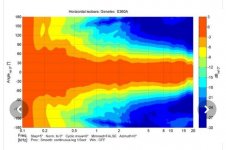
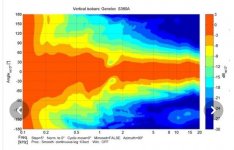
However, the horizontal performance does look very very good in Genelec's data (and the speaker was lauded). Not only there, also S&R's data shows it is a higly capable speaker with a very well controlled pattern. This is a high performance two-way waveguide speaker like the much older M2:
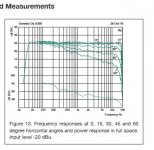
They use an asymmetrical device that is baffle-based. And it is round, a opposed to JBL's rectangular approach:
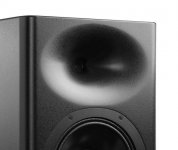
I have only learned from experimentation that rectangular devices have the advantage of longer wall lengths. However, if this is relevant could only be controlled when simulated in a baffle. They surely suffer from a discontinuous diagonal behaviour, something the oval waveguide maybe deals better with.
The detrimental effects of a baffle can be controlled to an extend that the whole system performs on highest levels. If we compare both applications, only with a peculiar intention it appears reasonable to me to talk in absolute peformance values. If instead objectives are set that amount for a high performance system-in-use, we will probably find this absolute performance difference to be a theoretical distinction. In this light, the pursuit of a pure approach sans baffled devices occurs to be more about personal taste. I could not see how it should be justified to leave this whole branch lie idle. But this is easy to say on my side, as I could not do programming work for this solution.
Just curious - why not?
I like a self-contained, more compact system. In my next warehouse studio (😉), I can pretty much imagine to run big free-standing statement horn speakers, like the horns that stand in the show room of a befriended local label, but with a much better curve at its base. Here, extraordinary shapes have a good place. But I know that if the baffled device was optimized for the enclosure, the performance advantage that is left could hardly justify this complexity in my living place, where I prefer a simple, modest box. Its performance would be very good.
Last edited:
The answer is no at this point because the MMM code is limited to infinite baffle conditions.Recently, fluid was so kind and made the effort to do a limited simulation in a baffle with ABEC. I needed to see how the performance changes on on a baffle. Drastically so. This showed to me that it is rather useless to optimize a baffled waveguide without regard to the diffraction effects generated by the box itself. Its impacts are too severe. Is it possible to do it with your new "API"
What you saw with your waveguide is the reason why I say that is quite a significant practical limitation if the idea is to optimize a final result. I don't say that to be obstructive but just to point out what I found myself and how difficult it was to use an infinite baffle simulation to optimize to a free space condition.
I thought your waveguide was pretty good in a baffle for what it was and if you put some smoothing, change the resolution and add some lines I think it stacks up OK next to the Genelec.
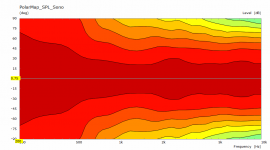
Don't forget that simulating a full 3D mesh never gives as smooth a result as an infinite baffle or circsym does, due to mesh frequency and other boundary differences.
This is a freestanding guide simulated as a 3D mesh, the circsym version has zero ripple
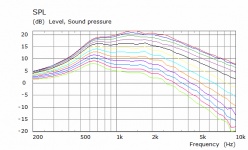
There is a bit of juggling to get the waveguide and enclosure working together and not against each other but it can be done. This is best I came up with and I see no reason why this would not measure very much the same if I built it.
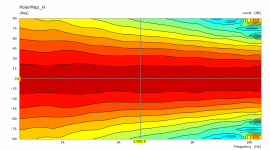
If smoothness of polar response is the parameter being targeted a baffled or freestanding waveguide made with Ath seems to be able to deliver.
The baffle and enclosure can help to control directivity to a lower frequency than the freestanding guide but getting the right dimensions to make them work together may or may not be found on the first try.
The freestanding guide controls directivity really well in a smaller overall size and seems to be more immune from external influence both in simulation and measurement.
The Tritonia shouldn't be forgotten for a baffled system that is non axisymmetric. For a Genelec S360 style speaker I don't think you could do better
Because I needed that...I don't see why you need Ath in the loop in the first place. For an infinite baffle simulation you can generate the waveguide contour directly in Matlab as the formula is readily available.
It was the first step to control Ath from Matlab in order to replace the Matlab MMM_toolbox solver by ABEC:
Matlab for Genetic algorithm, Ath to generate the profile and ABEC project, ABEC Demo to solve and finally import the results back into Matlab.
No more IB limitations.
Now it's all done, oddly it was not as painful as I had imagined. @Matbat and the R&D team are legends.
I still need to make sure everything is fine and see if I can leverage the Ath report function as a bonus instead of rewriting the whole thing but it's looking good ATM.
CNY is coming, I will look into that in depth then.
(Much) further down the line, I am looking into optimizing the box + waveguide as a whole, as l prefer the looks (I know, superficial...) and the better usage of the physical foot print (larger internal volume) of a "shoebox".
I suspect that it won't be lost on the midwoofer upper range to have an optimized box either.
Any tips on how to optimize the sim parameters to have shortest calculation time?
That would be greatly appreciated!
Ah, OK, with Ath and ABEC in the loop, I can see what you are doing. With the MMM_toolbox it didn't make sense to me.
Be sure to disable all the unnecessary output in the Ath script. Then depending on the complexity and size of the model, you can get to some tens of seconds per iteration I think (for axial symmetry of course). Not great but already usable. As always, set only as high a number of calculated frequencies and mesh density as absolutely necessary for reliable results.
Now I'm about to implement the new R-OSSE formula. I'm quite curious how it performs compared to what I already have.
If you thought Ath could be further improved for a better external loop usage (including the reporting), let me know, I have no problem with that - I'd love to see that happening.
Be sure to disable all the unnecessary output in the Ath script. Then depending on the complexity and size of the model, you can get to some tens of seconds per iteration I think (for axial symmetry of course). Not great but already usable. As always, set only as high a number of calculated frequencies and mesh density as absolutely necessary for reliable results.
Now I'm about to implement the new R-OSSE formula. I'm quite curious how it performs compared to what I already have.
If you thought Ath could be further improved for a better external loop usage (including the reporting), let me know, I have no problem with that - I'd love to see that happening.
Last edited:
BTW, this is an effect of an enclosure I repeatedly observe in the data - it's not helping the lower-end directivity. All it does is that it's actually a bit less controlled, compared to a "bare" free-standing waveguide (the DI is actually a bit lower below 1k when enclosed). This is without any additional flat baffle around the mouth, just a rear-side "housing" (all axisymmetric).



The corresponding results:



The corresponding results:
Last edited:
In that example you are right, the effect is seen at about 1.5K and it doesn't really help. The best curve for a baffle doesn't seem the same as one for free standing in my sims, getting the dimensions of the enclosure right to assist the waveguide is an important part of making use of it.BTW, this is an effect of an enclosure I repeatedly observe in the data - it's not helping the lower-end directivity.
I think you could use circsym like you did there to speed up finding the optimal result for a baffle, it certainly is a lot more effort the other way.
That's an interesting topic for sure. Have you already observed any hint of some "rules"?The best curve for a baffle doesn't seem the same as one for free standing in my sims, getting the dimensions of the enclosure right to assist the waveguide is an important part of making use of it.
What do you mean by saying "the best curve for a baffle"? What curve?
I have run enough simulations to see trends but not enough to formulate "rules". I don't think it would be too hard if the circym gave the same sort of result horizontally as a full 3D sim does. I will have to try that on some I have prepared earlier 🙂 There is an interaction between baffle width and enclosure depth and some ratios do work better than others at different frequency ranges and depending on the directivity that is trying to be matched. For example shallower than width tends to make the directivity more supercardioid.That's an interesting topic for sure. Have you already observed any hint of some "rules"?
Edit: The width and depth combination is more of a consideration for the woofer than the waveguide but they all need to work together to get the best result.
The actual waveguide profile. A profile that works with a freestanding termination doesn't seem to work as optimally when made into a baffle, as one that transitions to the baffle and then away like in a baffle mounted one would. In your example above the freestanding curve became the roundover, this does not seem to work quite as well as it can.What do you mean by saying "the best curve for a baffle"? What curve?
Edit: I think the ST260B was pretty good, from memory it was something like that I reverse engineered before you released it to get the response I showed above in #9246.
Last edited:
If anything, this shows how far easier it is to design a virtually flawless free-standing device, compared to this baffle hassle 🙂
ST260B (the baffled version) has a huge roundover for its size (see both profiles below), i.e. it will definitely take a wider baffle to behave as good as the free-standing version. Which is also something you mentioned I think. I'd be interested in a whole box simulation but I just don't have a reason to think it will work nearly as good.

ST260B (the baffled version) has a huge roundover for its size (see both profiles below), i.e. it will definitely take a wider baffle to behave as good as the free-standing version. Which is also something you mentioned I think. I'd be interested in a whole box simulation but I just don't have a reason to think it will work nearly as good.
Last edited:
This word pickking is getting diversive. Superfluous to point to the sentence before where its asymmetrical character was explicitly accounted.Elliptical is certainly not round.
- I see what I see and I stand by what I wrote 🙂
My impression is confirmed that you are generalizing your personal preference, despite evidence that a high performing baffle-mounted waveguide is possible.
I explicitly wrote about axisymmetric devices and you showed me a "counterexample" of an elliptical waveguide. In a sense it could be taken as supporting my point. I only say what I gathered from my own experience and all the real data I have seen so far.
My "personal preference" is solely based on data. Intuitively, I was quite sceptical about free-standing horns at first but the experimental data changed my mind. Since then I know that intuition in acoustics doesn't work (at all).
My "personal preference" is solely based on data. Intuitively, I was quite sceptical about free-standing horns at first but the experimental data changed my mind. Since then I know that intuition in acoustics doesn't work (at all).
Last edited:
Hope is this changes some time, this could be the tool kit I am missing!The answer is no at this point because the MMM code is limited to infinite baffle conditions.
What you saw with your waveguide is the reason why I say that is quite a significant practical limitation if the idea is to optimize a final result. I don't say that to be obstructive but just to point out what I found myself and how difficult it was to use an infinite baffle simulation to optimize to a free space condition.
I thought your waveguide was pretty good in a baffle for what it was and if you put some smoothing, change the resolution and add some lines I think it stacks up OK next to the Genelec.
Yes, it seems inpractical to work from IB. And thanks again many times for you effort! The vertical results where particularly off, compared to the IB results, and if there is a good reason to go round/eliptical, as Genelec did as opposed to JBL, then it is to get a contiuous pattern between horizontal and vertical. I wasn't too shure what was happening and found it to be out of my reach to do this itteratively in ABEC.
Now, this is nice!There is a bit of juggling to get the waveguide and enclosure working together and not against each other but it can be done. This is best I came up with and I see no reason why this would not measure very much the same if I built it.
View attachment 1018819
If smoothness of polar response is the parameter being targeted a baffled or freestanding waveguide made with Ath seems to be able to deliver.
It will suffer from the same limitations, the baffle diffraction should be accounted for.The Tritonia shouldn't be forgotten for a baffled system that is non axisymmetric. For a Genelec S360 style speaker I don't think you could do better
Pardon, I wasn't showing a counter example, I discussed rectangular and round/eliptical baffled-devices and practical application versus theoretical distinctions. I will not argue with your simulation results, the free-standing device has the advantage of less (baffle) diffraction. But this is within the realm absolute performance an this was not the point. I think I made this clear.I explicitly wrote about axisymmetric devices and you showed me a "counterexample" of an elliptical waveguide. In a sense it could be taken as supporting my point. I only say what I gathered from my own experience and all the real data I have seen so far.
I just showed a real-world measurement of a free-standing axisymmetric device that I consider to be an ethalon for the time being. There's nothing to talk about unless you show me something better. The Genelecs have obviously more diffraction and the JBL M2 is definitely not better in this regard either (see raw M2 data on Erin's website). And neither of those has a round (axisymmetric) horn - that would make things even worse.
- Are these differences subjectively/audibly significant? I don't know, they don't have to be. A lot of worse speakers sound "good enough".
- Are these differences subjectively/audibly significant? I don't know, they don't have to be. A lot of worse speakers sound "good enough".
Last edited:
I assume there is many gradations between what you paint as the average "good enough" speaker and the holy grail. An OSSE baffle-optimized baffle-mounted waveguide is probably not in the mediocre range of the every day commercial product, that serves as the fictional bottom end. But it certainly is not as pure and ideal a model! 😉
I just cannot advice to work on a baffle-mounted waveguide with ath yet, when the assumption is surpassing ready-made products. The response will show unaccounted deviations from infinite baffle simulation which will impact its perfomance significantly, and it is debatable if the gains will outweight the issues related to this. I assume commercial waveguides are optimized for a certrain baffle. If however the enduser is handy with ABEC/AKABAK, ath can provide great options, i. e. to set a dispersion pattern which is not freely available on the market and to optimize termination, even optimizing the waveguide and enclosure as one system.
I just cannot advice to work on a baffle-mounted waveguide with ath yet, when the assumption is surpassing ready-made products. The response will show unaccounted deviations from infinite baffle simulation which will impact its perfomance significantly, and it is debatable if the gains will outweight the issues related to this. I assume commercial waveguides are optimized for a certrain baffle. If however the enduser is handy with ABEC/AKABAK, ath can provide great options, i. e. to set a dispersion pattern which is not freely available on the market and to optimize termination, even optimizing the waveguide and enclosure as one system.
Well it's not true either that an IB simulation would be completely useless. I think what bmc0 did was also an IB sim at first. IIRC, he then only found out that the measured response in a box was only better (which could be simpy due to the generous edge roundovers). I also designed the Tritonia waveguide in an IB and it measured well. So I assume you just weren't lucky (or consider the results worse than they really are) 🙂
Last edited:
- Home
- Loudspeakers
- Multi-Way
- Acoustic Horn Design – The Easy Way (Ath4)